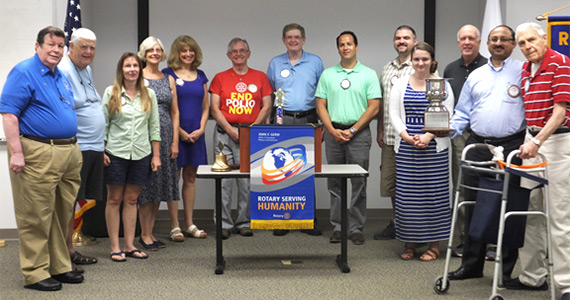
Members of the Rotary Club of James River, Richmond, Virginia, USA.
By Richard Cunningham, Rotary Club of James River, Richmond, Virginia, USA
To be continually successful in membership development through good times and bad, a club must know who it is – its appeal. It is important to have a vision statement (what the “end state” looks like) and a mission statement.
The emotional appeal of the wordings are most important. They come before the more detailed process components of a full package of change initiatives.
“When you discover your mission, you will feel its demand. It will fill you with enthusiasm and a burning desire to get to work on it.” -W. Clement Stone
A vision statement describes the desired future position of the club, perhaps 5 or 10 years ahead. A mission statement typically covers a shorter period, say three years and explains the club’s reason for existence. Developing relevant vision and mission statements are the first steps in the process of change.
A mission statement summarizes:
- The aims and values of a club
- The tasks and purpose that clearly dictate the action plan and the reason for it.
- The core purpose and focus
This serves a dual purpose by helping members to remain focused on the tasks at hand, as well as encouraging them to find innovative ways of moving toward achievement of the club’s goals. A mission statement answers the following questions:
- Why do we exist?
- What is our “business”?
- Who are our members?
- What do they value?
- What do we do to achieve the club’s vision?
Well written vision and mission statements are opportunities for attracting, engaging, or retaining volunteers, building organizational culture, and increasing service activities while leveraging all resources to successfully design and implement a strategic plan.
Understanding the mission gives members a better perspective on how their gifts of time and money contribute to achieving it, which can increase engagement, retention, and growth.
A study by Bain and Company indicated that organizations that have clearly defined vision and mission statements that are aligned with a strategic plan, outperform those who do not.
The ability to articulate the mission indicates its focus and purposefulness. This is Google’s. “To organize the world’s information and make it universally accessible and useful.” Googled” and “Googling” are now part of our vocabulary.
The most successful organizations spend abundant resources to create mission statements. Those statements are revised when conditions change. Here are some examples from great companies:
PepsiCo’s mission statement is “to provide consumers around the world with delicious, affordable, convenient and complementary foods and beverages from wholesome breakfasts to healthy and fun daytime snacks and beverages to evening treats.”
Starbucks Coffee’s mission statement is “To inspire and nurture the human spirit – one person, one cup and one neighborhood at a time.” The firm’s mission statement serves as an indicator of what the company wants to do at the core of its business.
A club’s mission statement should identify actions to achieve the club’s vision – and the mission statement and vision statement must be aligned with a future organizational chart, the club’s current strategic plan and be supported by its bylaws.
So when was the last time your club/board reviewed (and revised, if necessary) your:
- Vision Statement?
- Mission statement?
- Organizational Chart?
- Strategic Plan?
- Bylaws?

Reblogged this on shanakyar.
LikeLike
Good material for Rotary club
LikeLike
Pingback: Why vision and mission are critical to a club | The Rotary Club of Carteret
This applies to Rotary International, not just its clubs. I totally disagree even implying that Rotary club members are volunteers. They are not. Most of the over 7 billion people in the world volunteer to do things. Rotary clubs are small businesses. Small businesses do not run on volunteers; they run on having people paying to receive something of value. Membership in a Rotary club, and a group of people who choose to become a Rotary club, can and should receive a benefit for doing so, but not if they are considered ordinary volunteers.
LikeLiked by 1 person